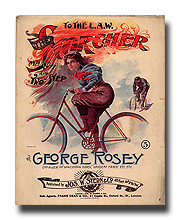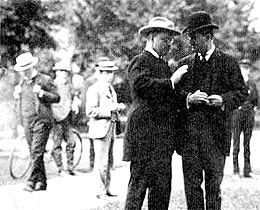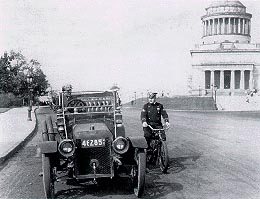 |
|
|
| |
 |
|
|
| |
| The Wheel - 1880 - 1885 - 1890 - 1895 - 1896 - 1897 - 1899 - 1900 - 1905 - 1910 |
 New York Police Department, Spring 3100 Created by Police Commissioner Theodore Roosevelt in 1895 to apprehend speeding horse-drawn carriages, the 29-member bike squad, known as the "Scorcher Squad," made 1,366 arrests in its first year. By the end of 1917, the NYPD had 276 motorcycles, 1,025 bicycles, 327 horses and 86 cars, wagons and trucks. May, 1895 The mounted squad have, of course, many opportunities to distinguish themselves in stopping runaways. In May, 1895, a mounted policeman named Heyer succeeded in stopping a runaway at Kingsbridge under rather noteworthy circumstances. Two men were driving in a buggy, when the horse stumbled, and in recovering himself broke the head-stall, so that the bridle fell off. The horse was a spirited trotter, and at once ran away at full speed. Heyer saw the occurrence, and followed at a run. When he got alongside the runaway he seized him by the forelock, guided him dexterously over the bridge, preventing him from running into the numerous wagons that were on the road, and finally forced him up a hill and into a wagon-shed. Three months later this same officer saved a man from drowning. The members of the bicycle squad, which was established shortly after we took office, soon grew to show not only extraordinary proficiency on the wheel, but extraordinary daring. They frequently stopped runaways, wheeling alongside of them, and grasping the horses while going at full speed; and, what was even more remarkable, they managed not only to overtake but to jump into the vehicle and capture, on two or three different occasions, men who were guilty of reckless driving, and who fought violently in resisting arrest. They were picked men, being young and active, and any feat of daring which could be accomplished on the wheel they were certain to accomplish. Three of the best riders of the bicycle squad, whose names and records happen to occur to me, were men of the three ethnic strains most strongly represented in the New York police force, being respectively of native American, German, and Irish parentage. The New York Police Department currently deploys bicycles in 51 precincts throughout the city. Citywide, the bicycle patrols are funded by dozens of different organizations — from civic groups to business leaders to community boards. Bike patrol officers pay for their own special uniforms.The German was a man of enormous power, and he was able to stop each of the many runaways he tackled without losing his wheel. Choosing his time, he would get alongside the horse and seize the bit in his left hand, keeping his right on the crossbar of the wheel. By degrees he then got the animal under control. He never failed to stop it, and he never lost his wheel. He also never failed to overtake any "scorcher," although many of these were professional riders who deliberately violated the law to see if they could not get away from him; for the wheelmen soon get to know the officers whose beats they cross. The Yankee, though a tall, powerful man and a very good rider, scarcely came up to the German in either respect; he possessed exceptional ability, however, as well as exceptional nerve and coolness, and he also won his promotion. He stopped about as many runaways; but when the horse was really panic-stricken he usually had to turn his wheel loose, getting a firm grip on the horse's reins and then kicking his wheel so that it would fall out of the way of injury from the wagon. On one occasion he had a fight with a drunken and reckless driver who was urging to top speed a spirited horse. He first got hold of the horse, whereupon the driver lashed both him and the beast, and the animal, already mad with terror, could not be stopped. The officer had of course kicked away his wheel at the beginning, and after being dragged along for some distance he let go the beast and made a grab at the wagon. The driver hit him with his whip, but he managed to get in, and after a vigorous tussle overcame his man, and disposed of him by getting him down and sitting on him. This left his hands free for the reins. By degrees he got the horse under control, and drove the wagon round to the station-house, still sitting on his victim. "I jounced up and down on him to keep him quiet when he turned ugly," he remarked to me parenthetically. Having disposed of the wagon, he took the man round to the court, and on the way the prisoner suddenly sprang on him and tried to throttle him. Convinced at last that patience had ceased to be a virtue, he quieted his assailant with a smash on the head that took all the fight out of him until he was brought before the judge and fined. Like the other "bicycle cops," this officer made a number of arrests of criminals, such as thieves, highwaymen, and the like, in addition to his natural prey — scorchers, runaways, and reckless drivers. The third member of the trio, a tall, sinewy man with flaming red hair, which rather added to the terror he inspired in evil-doers, was usually stationed in a tough part of the city, where there was a tendency to crimes of violence, and incidentally an occasional desire to harass wheelmen. The officer was as good off his wheel as on it, and he speedily established perfect order on his beat, being always willing to "take chances" in getting his man. He was no respecter of persons, and when it became his duty to arrest a wealthy man for persistently refusing to have his carriage lamps lighted after nightfall, he brought him in with the same indifference that he displayed in arresting a street-corner tough who had thrown a brick at a wheelman. — Theodore Roosevelt, writing about The New York Police, excerpted from Chapter VI of An Autobiography - 1913 On Nov. 8, 1898, Roosevelt was elected governor of New York State and two years later was elected vice president of the United States. At 42, he became the youngest President of the United States when William McKinley succumbed to an assassin's bullet. America's conservation President set aside more than 230 million acres of land as 150 national forests, 51 federal bird reservations, 4 national game preserves, 5 national parks, 18 national monuments and 24 reclamation projects including Crater Lake National Park and 15 National Forests in Oregon. For more, read Theodore Roosevelt & the Siuslaw National Forest. |
|
Tens of thousands of bicyclists clogged New York City streets at all hours during the 1890s. Broadway and the other avenues buzzed with the sound of wheels. Charles Duryea is credited with introducing the drop-frame on his Sylph bicycles first produced in Chickopee, Mass. After building the first successful automobile in 1893, Charles and Frank Duryea became the first American automakers, producing 13 vehicles in Peoria, Illinois three years later -- when Henry Ford was still fitting a bicycle chain to his Quadricycle. It's no great suprise, then, that a Massachussetts man, probably driving his Duryea, met a New York woman riding her bicycle in the city's first recorded automobile accident on May 30, 1896.  A conversation with T.R. . . . When it came to picking out the man who was to command in the East, where the blow must be struck, Roosevelt picked Dewey. They laughed at him. Dewey was a "dude," they said. It seems the red tape had taken notice of the fact that the Commodore was always trim and neat, and, judging him by its own standard, thought that was all. Roosevelt told them no, he would fight. And he might wear whatever kind of collar he chose, so long as he did that. I remember, when Dewey was gone with his ships, the exultation with which Roosevelt spoke of the choice. We were walking down Connecticut Avenue, with his bicycle between us, discussing Dewey. Leonard Wood came out of a side street and joined us. His mind was on Cuba. Roosevelt, with prophetic eye, beheld Manila and the well-stocked ammunition-bins in Chinese waters. "Dewey," he said, "is the man for the place. He has a lion heart." I guess none of us feels like disputing his judgment at this day, any more than we do the wisdom of the gun-practice. When Dewey was in the East, it was Rooseveltís influence in the naval board that kept his fleet intact. The Olympia had been ordered home. Roosevelt secured the repeal of the order. "Keep the Olympia," he cabled him, and "keep full of coal." The resistless energy of the man carried all before it till the day when orders were cabled under the Pacific to the man with the lion heart to go in and smash the enemy. "Capture or destroy!" We know the rest. Rooseveltís work was done. "There is nothing more for me to do here," he said. "Iíve got to get into the fight myself." — Jacob A. Riis, writing The Clash of War in Theodore Roosevelt, the Citizen - 1904  NYPD traffic stop at Grant's Tomb, 1910. NYPD History NYPD Bike Patrols to Brooklyn's 66th Precinct NYPD Motorcycle Squad New York City Police Museum Traffic Control in New York City With the first bikeways, the first bike cops, the first automobile-bicycle collision, the biggest mass ride and more, New York holds many distinctions including the dubious title of the bicycle theft capital of America, according to the Kryptonite Lock Corporation, the developers of the familiar U-Lock. 1. New York, NY 2. Chicago, IL 3. Miami, FL 4. Philadelphia, PA 5. Washington, DC/Baltimore, MD 6. San Francisco, CA (+ Berkeley, Oakland) 7. Boston, MA (+ Cambridge, Somerville) 8. Portland, OR 9. Denver, CO (+ Littleton) 10. (tie) Austin, TX 11. (tie) Los Angeles, CA 12. (tie) San Diego, CA  Chicago Police Department Sergeant Joseph Andruzzi, Jr. and members of the Chicago Police Department Bicycle Patrol Unit at Lake Shore Drive on Chicago's "Gold Coast." The unit was established in 1992 and since then has been operating primarily along the 26 miles of lakefront bike paths. Each year they patrol large-scale events such as Bike Chicago, the Taste of Chicago, the Boulevard Lakefront Tour and the Chicago Marathon.  Robin Layton / Seattle Post-Intelligencer Outside the Convention Center, Seattle Police Officer B. Conway issues a warning to "Rozl" after being hit by the protester's pole, which sported a giant wooden butterfly at the end. Rozl replied, "No problem, it was an accident." (November 29, 1999) 1895: Bikeways Next: 1896 See 19th Century Bicycle News for a selected bibliography and historical resources online, or use the links to find other sites of interest. All rights reserved. |